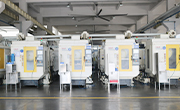Precision mould casting is a casting method that can achieve relatively clear shapes and relatively high casting precision compared to traditional casting processing. Let's listen to the heat treatment methods of precision mold processing together!
The common practice for precision mold processing is to first make an electric level that requires a rough embryo (with little or no capacity left), then use the electric level to erode the mold to form an inner cavity, and then use a casting method to cast wax to obtain the original wax mold. Brush the wax mold layer by layer with heat-resistant liquid sand, and after obtaining sufficient thickness, air dry it before heating it up to melt the internal wax mold, obtaining a concave mold that shares the desired rough embryo, Pour molten steel into the concave mold again, dry and solidify it, and then peel off the casing to obtain precision manufactured products. Cracks are quite common during the low-pressure casting process of precision casting. The production and processing design of precision casting molds is not scientific, and the difference in thickness and level of the diagonal wall usually causes cracks. It is sooner or later to carry out inspections based on the crack condition and improve the overall design of the mold. Only by making the mold design effective can it help solve the problem.
Low pressure casting technology is widely used in domestic manufacturing processes, and with the development of technology, its shortcomings have become increasingly apparent. Precision casting manufacturers also have to consider the fundamental reasons for the problems.
There have been changes to the second type heat treatment process for precision mold processing of stainless steel plates, which can be divided into five categories:
1. Softening quenching: The main purpose is to dissolve the carbide, reduce its strength, and improve production characteristics. For molds, the purpose is to obtain more organizational structure.
2. Quenching process: The purpose is to obtain pearlite and sorbite structures to improve the physical properties of stainless steel plate casting.
3. Quenching treatment: The key is to obtain high strength or wear compressive strength, while also obtaining surface wear resistance characteristics.
4. Surface hardening solution: The key is to obtain a surface hardening layer while also obtaining high surface wear resistance characteristics.
5. Hardening treatment is performed to achieve high toughness, while elongation does not result in drastic changes.
The role of precision molds is that in commodities such as electronics, vehicles, electric motors, instruments and equipment, household appliances, instrument panels, electrical appliances, and communication, 60% -80% of the components used for casting molds need to be formed using molds. The concept of high precision, high complexity, high consistency, high production efficiency, and low consumption exhibited by home mold production and manufacturing parts in precision mold manufacturers is incomparable to other production and manufacturing methods. A mold is a specialized tool for concave molds with a certain appearance and size, which can be used in conjunction with various equipment or organizations inside the mold, By adding various raw materials (such as plastic or metal alloys) of continuously high-temperature liquids into the mold cavity, precision mold manufacturers can manufacture industrial parts with special shapes, specifications, performance, and quality.
Zhigaoyuan focuses on the research and development, production, sales, and service of medical devices, various medical consumables, and medical packaging molds. The company introduces various mold production equipment and testing instruments and achieves constant temperature management. The management adopts a mold ERP management system, and fully introduces information management in the workflow.











